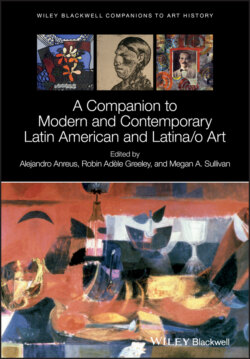Читать книгу A Companion to Modern and Contemporary Latin American and Latina/o Art - Группа авторов - Страница 25
1.2.4 Rufino Tamayo
ОглавлениеAnd, now, Tamayo. Rufino Tamayo (1899–1991) is often referred to as the fourth muralist, or the Fourth Great One, a condescension that he forcefully refuted.5 In this charged relationship to the Big Three and in my ironic opening sentence is captured the vast but vexed importance of this extraordinarily prolific painter who worked mostly in framed easel painting. At times considered an afterthought and at times a forceful rejoinder to the Big Three, the murals of Tamayo occupy a place of opposition to their politicized nationalism and display an awareness of advanced European and American abstract style and thus a commitment to a Mexican presence in international modernism. His murals are at once deeply indebted to cubist figurations on the one hand and colors derived from Mexican folk arts on the other. Human figures are rendered in refracted shards of saturated reds, blues, or yellows, sometimes barely registering human anatomy. The subject matter is of the timeless and universal conditions of existential angst and of deeply symbolic recyclings of ancient Mexican mythology. There are no narratives of the Mexican Revolution or critiques of Yankee capitalism, and certainly no Marxist indulgences.
Perhaps the best example of his murals with the greatest public exposure is Nacimiento de la nacionalidad (Birth of Our Nationality), 1952, located in the Palace of Fine Arts, Mexico City. It is a large wall painting on canvas, affixed to the wall, rather than a fresco. This is not an inconsiderable point, as the fresco technique favored by Rivera and Orozco was unavoidably tinged with old world technology and also obligated to a strict adherence to the given architectural setting. The production of frescoes in public view, as it were, loads them with a stressed social situatedness that studio‐produced murals lack by definition. Studio production is also weighted with the possibility of future transfer to other locations, and perhaps other owners, raising the potential of commodification not applicable to frescoes.
Nacimiento de la nacionalidad, located in the atrium of the Palace of Fine Arts, places it in the same interior space as earlier, major murals by the Big Three themselves, thus creating a convenient venue for comparing Tamayo to his ideological and stylistic adversaries. Staking out his place in what essentially makes up a museum of Mexican muralism (Rivera's example is from 1934, Orozco's from 1935, and Siqueiros' from 1945 and 1951), and from his privileged vantage looking back at his competition, Tamayo presents an uncompromised modernist style of violently exploding forms and rocky shapes seemingly tumbling into the viewers' space, the imagery dramatically imposing itself upon the hapless, tiny human. Because the style is so abstract, the subject of a Spanish conquistador wielding ferocious power astride a demonic horse becomes a metaphor for European‐derived modernism also invading the nationalist domain of Mexico and of The Big Three.
